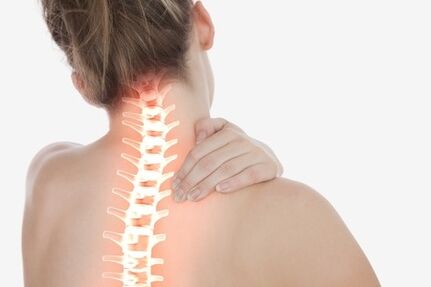
Cervical osteochondrosis is a very common disease.His symptoms probably at least once felt every person.The disease can provoke dangerous complications, so it is important to identify it as soon as possible and begin treatment.
What is it?
Osteochondrosis is a degenerative disease, The affecting structures of the spine with the primary and secondary mechanism.At first, degenerative-dystrophic processes appear only in intervertebral discs, but in the future both muscle and bone tissue is affected.
In the early stages, the disease may not manifest itself in any way, but then characteristic symptoms arise that seriously worsen the quality of a person.Earlier, osteochondrosis was considered an age -related disease.Nevertheless, recently, young people have increasingly suffered from him.
The reasons for its occurrence
The main factors that provoke osteochondrosis of the spine in the cervical region are as follows:
- Inactive lifestyle.In the absence of loads, the muscles fixing the spinal column are weakened.Metabolic processes and blood circulation in intervertebral spaces are slowing down.
- Congenital pathologies of the spine, such as the anomaly of the Kimmerle or the Arnold-Kiari anomaly.
- Acquired spinal deformations:
- scoliosis;
- kyphosis.
- Prolceless age.Age changes can be accompanied by deformation of the vertebral discs and the growth of osteophytes.
- Violation of posture, stoop, long -term stay in an uncomfortable position.
- Injuries of the cervical region.
- Asymmetric load on the shoulders.Can lead to this:
- constant wearing a heavy bag on one shoulder;
- Application for sleeping a soft large pillow, which is why the neck bends.
There are other factors that increase the risks of cervical osteochondrosis:
- intensive physical activity;
- genetic predisposition;
- hypothermia;
- overweight;
- Frequent stresses.
Many of these factors can provoke osteochondrosis and other spine.
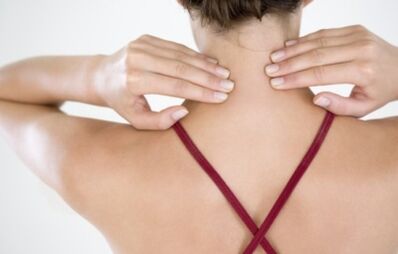
What is dangerous?
Cervical osteochondrosis is one of the most dangerous spinal lesions. This is explained by the fact that in the neck there is a large number of vital arteries, blood vessels and capillaries.The disease can provoke:
- hypertension;
- vegetative-vascular dystonia;
- oxygen starvation;
- and so on.
General symptoms and signs
It is easy to recognize the disease.It manifests itself as a number of characteristic symptoms that cause a person serious discomfort.
Pain in the back of the head, neck and collar area
Pain syndrome - a basic symptom of cervical osteochondrosis. Pain appears:
- head;
- in the neck;
- In the collar zone.
They can radiate in the hand, especially against the background of sudden movements and after waking up.Unpleasant sensations are usually localized in deep tissues of the neck.When turning the head, pain and crunch may occur.
Noise, ringing, sensation of congestion in the ears
Often patients feel congestion in the ears. Sounds of various intensities arise that are not related to an external source.They can manifest itself both in one and two organs of hearing.The cause of this phenomenon is a violation of blood supply.
Dizziness
Dizziness is also associated with circulatory disorders.Nystagmes are often added to them - arbitrary fluctuations in the pupils to the sides.
Air lack
A feeling of lack of air occurs due to irritation of the ends of the diaphragmatic nerve.Patients often complain about the inability to take a breath in full.
The symptom can lead to severe shortness of breath and suffocation.For a similar reason, it is possible:
- Stop breathing at night;
- snore.
Lack of oxygen due to respiratory disorders causes:
- increased fatigue;
- memory disorders;
- Violations of concentration.
Nausea
Nausea manifests itself along with airing.It is also associated with circulatory disorders in some areas of the brain and inner ear.Unplicable vomiting with the movements of the head and body is possible.As a result, man:
- loses appetite;
- loses weight;
- Alimentary failure arises.
Problems with vision
Deterioration of visual acuity, “flies” and fog in the eyes are the result of ischemia of the brain. responsible for vision.Therapeutic gymnastics and wearing glasses are usually ineffective.Vision normalizes only after the treatment of the disease.
Board of blood pressure
Unstable pressure is explained by a violation of blood flow in the oblong brain responsible for the functioning of the vascular-motor center.
Sudden fainting, or syncopal states
It appears due to the spasm of the arteries of the brain due to the short -term cessation of blood flow along the vertebral arteries.The patient can be quickly returned to consciousness, laying it in such a way that the legs are slightly higher than the head. After an attack of fainting, reversible speech and movements may be observed.
Glooping signs
Sometimes they are the only sign of pathology.Manifests itself:
- dryness and feeling of the presence of a lump in the throat;
- perspiration;
- Problems with swallowing.
Raising body temperature
An increase in temperature is not the most typical sign of the disease. It occurs rarely and locally - in the cervical or collar area, and is accompanied by light redness of the skin.
Symptoms that occur in the brain
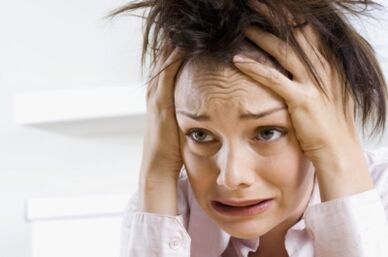
The disease leads to a violation of the blood supply to the cerebral alignment through the arteries, which is compressed by the protruding edges of the vertebrae.In view of this, blood circulation of the brain is disturbed.Patients manifest disorders of a neurotic nature:
- anxiety;
- irritability;
- insomnia;
- frequent mood change;
- Concentration deterioration.
Sometimes possible:
- fear;
- yearning;
- outbreaks of anger.
Vascular spasms provoke:
- headache;
- fainting;
- noise in the ears;
- Points before my eyes.
Perhaps the defeat of the vestibular apparatus that makes itself felt:
- dizziness;
- losing equilibrium;
- nausea;
- vomiting.
Classification
Cervical osteochondrosis is classified according to the development stage. There are four of them in total:
- The first degree. It is a gap or displacement of the intervertebral discs.Sharp movements and increased loads provoke shooting pain.
- The second degree. Propulation occurs.The pains are constant, intensify with prolonged inaction.Dizziness may occur.
- The third degree. Symptoms at this stage are similar to the vertebral hernia.All side effects occur, including the deterioration of hearing and vision.
- The fourth degree. At this stage, the symptoms cease to be pronounced.It is accompanied by instability of the spine.The spinal nerves are transmitted, spinal cord ischemia occurs.
Diagnostics
First, the specialist listens to the patient’s complaints, evaluates soreness and mobility in the neck area, sensitivity and other disorders.It will be necessary to pass the radiography of the cervical region in several projections.
Magnetic resonance and computed tomography can be shown.In case of circulatory disorders, reoencephalography is performed, as well as the study of the fundus.
Which doctor to contact?
First, when the symptoms of osteochondrosis are manifested, you need to contact the therapist. In the future, he will direct to a narrower specialist.After making a diagnosis, you will have to visit a radiologist.Also, the treatment of the disease is engaged in:
- Manual therapist;
- vertebrologist;
- osteopath;
- Neuropathologist.
Such a specialist as a physiotherapist, with cervical osteochondrosis, prescribes a complex of physiotherapy exercises.
Syndromes caused by the disease in this spine
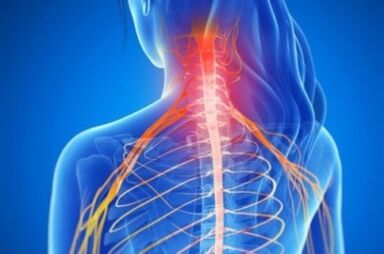
Osteochondrosis can provoke changes in nerve plexuses and fibers, vascular disorders.There are common syndromes due to this disease:
- Rook syndrome. The rooser syndrome is not often manifested.The roots of the spinal nerve endings are affected, which leads to:
- decrease in muscle tone;
- partial violation of mobility;
- The pallor of the skin.
- Vail artery syndrome. With this syndrome, headaches occur already in the early stages.They are diffuse.The pain is mainly manifested in the cervical-and-consuming region.
Pain in this case is constant, periodic exacerbations are observed, especially in the morning.Perhaps dizziness, sometimes - vision and hearing disorders.Such syndromes are associated with compression of the vertebral arteries of bone-fibrous growths.When turning the head, symptoms can worsen.
- Cervical migraine syndrome. This syndrome is not related to the usual migraine.Its name is due to the fact that pain affects only half the head and part of the neck.
It manifests itself in a headache in the cervical-and-consuming region and spreads into the zone of temples and crown, as well as in the eye on the one hand.The pain can be paroxysmal and accompanied by vomiting.
- Hypertension syndrome. The early symptom of the syndrome is headaches, intensifying with the turns of apples of the eyes and heads.Possible vomiting and nausea.
The attack on average lasts 2-5 hours.The syndrome of squeezing veins and arteries is explained, which violates the venous shade and provokes an increase in intracranial pressure.
Effective treatment
The treatment of the disease should be complex. It is important not only to eliminate the symptoms of cervical osteochondrosis, but also to affect its cause.

First aid
In some cases, the pain becomes unbearable, and a visit to a specialist has to be postponed.
- To relieve pain syndrome, it is recommended to take an analgesic drug.
- You can also apply a pepper patch, but keep in mind that it gives only temporary relief.
- To remove edema, it is recommended to drink herbal decoctions for several days.
Medicines
The following groups of medication are used for treatment:
- Funds for removing muscle spasm (muscle relaxants).
- Non -steroidal anti -inflammatory drugs that relieve pain, inflammation, swelling.
- Vitamins for improving metabolic processes in the nervous system.
- Medicines for restoring cartilage tissues and eliminating damage in intervertebral discs.
- Means for improving the nutrition of nerve cells and normalizing blood circulation of the brain.
Physiotherapy
The following physiotherapy methods can complement the treatment:
- Electrophoresis. Due to the action of the electric current, ion of the analgesic drug penetrate the affected area due to the action of electric current.
- Laser therapy:
- relieves inflammation;
- Improves blood circulation.
- Magnetic therapy:
- eliminates pain;
- Helps relieve swelling of the fabrics.
- Ultrasound:
- relieves pain and inflammation;
- Improves metabolic processes.
Learn about other methods that are used along with traditional therapy.Special devices have a positive effect on the body, and the combination of drug treatment with the methods of kinesiteropia and therapeutic exercises give good results and numerous positive reviews.The use of orthopedic devices, such as cervical collars, acupuncture and shaft bandage eliminate unpleasant symptoms, relieve pain and improve the general emotional state.
Exercise therapy
Exercises for therapeutic exercises should be prescribed by a doctor.In the process of its implementation, pain and discomfort should not occur. Here are some examples of exercises:
- It is necessary to lie down with your stomach, leaning on your hands.The back should be flat.The head and body rise.In this position, you must linger for two minutes, then return to the original.2-3 repetitions are made.
- In the position of lying on the floor with your hands stretched along the body, you need to touch the floor with your ear, turning your head to the left.Make 6-7 repetitions for each side.
- In a position sitting on the floor, a tilt forward is made.In this case, you need to try to touch your chest with your head.When you exhale, a tilt is made back and your head is thrown back.It is necessary to perform 10-15 repetitions.
- Pressing on the forehead, you need to lower it to the palms, sitting on the floor.An exercise is done in 2-3 approaches half a minute.
- Smooth circular rotations are performed with the head, 10 in each direction.
Massage
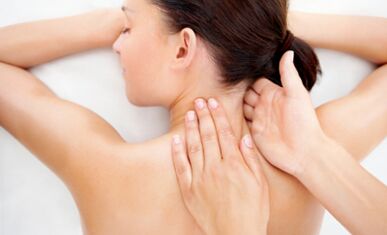
Massage includes classic elements.It can be performed at home.They begin it with a healthy site with a gradual transition to a sore area.The complex must be selected individually.
The patient must lie horizontally during the massage process, stretching the chin to the chest and relaxing the cervical muscles.Therapeutic massage can include the following techniques:
- Strokeing movements starting with a collar area.
- Squeezing from neck to spine.
- Rubbing the neck in the direction of the spine.
- Remaining the neck with circular movements.
- Vibrational movements with striking.
Surgical intervention
If conservative treatment does not give results, and there are risks of the development of complications, the operation may be shown.Surgical intervention is carried out at the rear or anterior access to the affected disks.Typically, the operation demonstrates effectiveness, but the rehabilitation period after it is quite long.
Home treatment
At home, you need to use a set of measures prescribed by a doctor. Treatment includes:
- taking medications;
- performing special exercises;
- Therapeutic gymnastics.
Folk remedies
Of the folk recipes, the following can be used:
- A horseradish sheet can be applied to the sore area, fixing it with a bandage or cloth.Previously, it is recommended to pour it with boiling water and cool.It is better to leave the bandage at night.
- You need to cut the potatoes and mix it with honey in equal proportions.Apply once a week as a compress.
- To relieve pain, warming can be used.Mustard, peppers, etc. are used.
This disease today is very successfully treated.The main thing is to accurately comply with all the recommendations and prescription of the doctor.Along with conservative treatment, methods and methods such as self -massage, including electric massager, fir oil, kinesiology, leech and acupuncture, are used.
Possible consequences and complications
In the absence of treatment, degenerative processes of intervertebral discs will lead to a loss of their functionality and a decrease in density.Over time, excessive mobility of the spine develops, muscles, ligaments, joints are affected.
The common complications of cervical osteochondrosis are as follows:
- frequent migraines;
- muscle cramps;
- vegetative-vascular dystonia;
- hearing impairment and vision;
- hypertension or hypotension;
- hernias.
Contraindications
It should be borne in mind that the treatment methods for cervical osteochondrosis have contraindications.Contraindications to medications can be found in the instructions.
Massage, physiotherapy and physical activity can be contraindicated in such cases:
- bleeding and disease of the circulatory system;
- respiratory system diseases;
- tracked pathologies;
- Mental disorders characterized by excessive excitement.
Exercise therapy can be prescribed only at the remission stage. In the process of its implementation, the appearance of pain is not allowed.

Prevention
Methods of prevention of osteochondrosis of the neck are reduced to such measures:
- moderate physical activity;
- proper nutrition;
- regular warm -ups at sedentary work;
- the right choice of mattress and pillows for sleep;
- Elimination of overweight.
Diet and nutrition
The development of osteochondrosis is associated, including with a lack in the cartilage of the necessary elements.The connective tissue must be saturated:
- proteins;
- calcium;
- magnesium.
The diet should have enough:
- meat;
- fish;
- legumes.
We also need fiber, the sources of which are vegetables and cereals.It is important to drink a sufficient amount of water and consume sour milk products.The diet is limited:
- sweet;
- flour;
- fat;
- Fried.
Also not recommended:
- strong coffee;
- alcohol;
- Shipy drinks.
Doctors' advice
In addition, patients should take into account the following recommendations:
- It is worth considering that medicines mainly relieve the symptoms of the disease, but do not fight its causes.Therefore, other methods cannot be ignored.
- Using folk recipes, take into account the possibility of allergic reactions.
- Patients with osteochondrosis cannot be lifted by severity.It is worth avoiding sudden movements.
- Physical exercises are contraindicated in exacerbation of the disease.
Osteochondrosis of the cervical spine can provoke numerous dangerous consequences.To warn them, you need to contact a specialist as soon as possible and start timely treatment.It is necessary to adhere to all medical recommendations and lead the right lifestyle.























